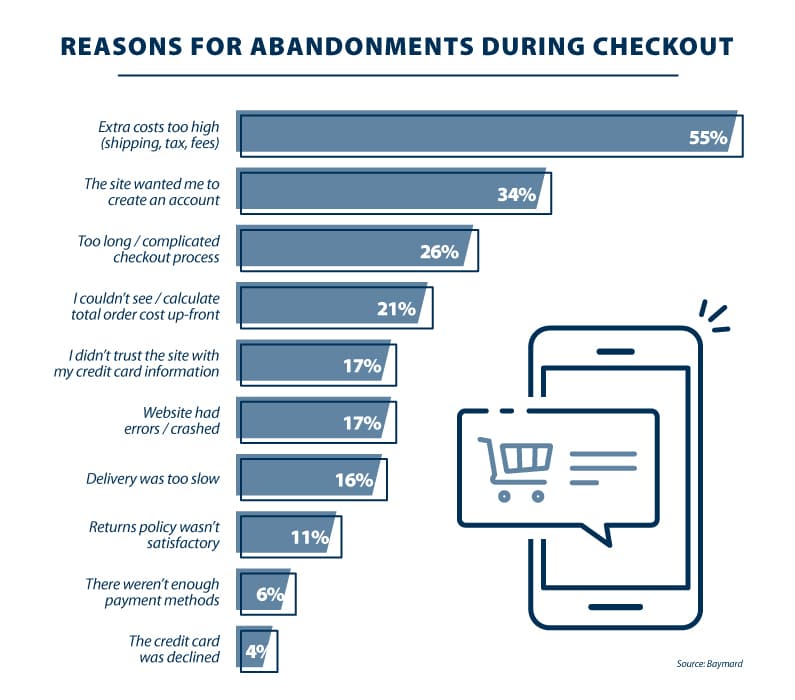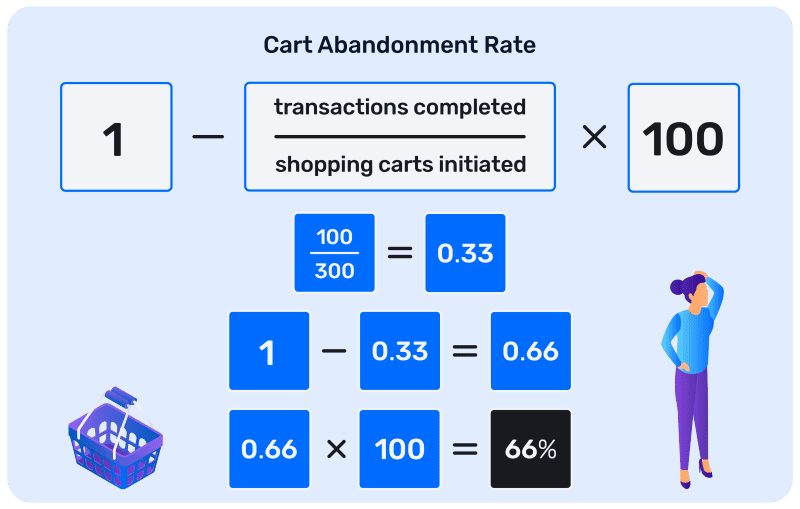
Shopping carts are essential for the success of any e-commerce business, so it is important that we put plenty of thought and consideration into how effective they are. Cart abandonment rates are almost up to a staggering 70%, and with businesses set to lose a combined total of more than 4 trillion dollars in the next year, it is vital to be proactive with your e-commerce cart features.
Tackling shopping cart abandonment effectively often means improving various areas of your shopping platform. This may be anything from the general browsing experience to website security or the fluidity of the checkout process itself.
Source: Bolt
The Most Common Reasons for Cart Abandonment
Although cart abandonment is ideally something merchants would like to completely eradicate, that will never be the case. This is simply because there are too many variables out of your control, including human behavior, a person’s location, or their income.
Furthermore, many shoppers aren’t entirely serious about buying. They may even be adding items to the cart to compare prices with other stores. But even if shopping cart abandonment cannot be completely prevented, it would be best if it could be lessened. However, to know how to reduce cart abandonment, we first have to acknowledge the most common reasons for the issue in the first place.
According to the data below, there are a wide range of reasons for cart abandonment. Anything from a bad returns policy to being forced to create an account can deter customers from finalizing their purchase.

Source: Baymard
So what are the best ways to combat shopping cart abandonment? Here are our top eight proven methods.
1. Offer Free Shipping and Returns
Free shipping and returns can be a great incentive for someone to finalize their purchase, rather than abandoning their cart. Many of those browsing and considering purchasing will be deterred by sudden additional fees being added once they reach the cart, especially if the shipping charges are on the higher side. By offering free shipping, you take away the deterrent and actually add another incentive to complete the purchase. Free returns also add an incentive to complete the purchase, especially for those who are unsure if the product is right for them. A free-returns policy is particularly effective when selling clothing online, as people can try on multiple sizes at home, without the detrimental effect of additional cost if someone doesn’t fit.
2. Allow Guest Accounts
Allowing guest account when purchasing is a great incentive for potential buyers. Guest accounts make first purchases a little less of a hassle for the customer, but more importantly, they feel far less intrusive. This is because they only ask for the essential details to complete the purchase and deliver the product. After a guest account purchase is made, you can still offer incentives of your own to encourage the customer to sign up completely, so you don’t really lose anything from the transaction. If anything, a customer will be more likely to sign up and buy again from your brand in the future, dueto the ease of the purchasing process.
You can even take guest account purchasing one step further and allow sign up through social media. This will speed up the sign up process for the customer, as they are probably already signed into social media, and it will auto-fill the majority of the data form for them.
3. Retarget Your Customers
Many customers will leave their shopping carts with the intention of coming back to it at a later date. Online shopping is often used for its convenience, so this is a fairly frequent occurrence. However, customers will also frequently forget about their previous shopping cart completely. This is when retargeting is useful. By retargeting customers who abandoned their shopping cart, you may reignite their desire to make the purchase. With the help of an effective data feed optimization service, you can narrow the best options for retargeting by the value of a product or even what is on sale. This may help to increase profitability when you advertise through Google text ads, email, or dynamic ads.
4. Optimize Your Site for Mobile and Tablet
By optimizing your website for mobile and tablet, you will not only get more customers completing their purchase, but you will also get more customers in general. In fact since 2017, around 50% of all online purchases have been made through mobile or tablet. This means having an effective mobile site is essential.
On smaller screens, the desktop version of a website can often be difficult, if not impossible to use without optimization. This deters customers from browsing through your website, which means purchases are far less likely to be completed. If you optimize your website for other platforms, each page will be suited to the downsize in screen. This will make it easier for customers to browse, enter address details, and payment details.
5. Offer Numerous Payment Methods
As many online stores attract customers from all over the world, a diverse range of payment options is essential. This is because customers will not necessarily have the same payment habits, income levels, and may not even have access to the same payment brands as one another. By offering numerous forms of payment, customers will be more likely to complete their purchase. Useful payment methods that may benefit you and your customers include
- Credit/debit cards
- Secure third-party payment options, such as Securepay or Stripe
- Gift cards or discount vouchers
- Staggered payments via one of the payment methods (e.g. 3 installment payments of $20 instead of $60)
- Apple or Google Pay
- PayPal
6. Ensure the Shopping Experience Is Secure
If a customer is going to enter payment details into your website, they will want to know if it is secure. Try to make sure your security is clear and visible with an SSL seal, especially on the payment page. Otherwise, customers may abandon their cart simply because your site doesn’t seem safe, even if it is. Visual factors help to build up trust between the brand and customer, so this will also make customers more likely to make future purchases.

Source: Krishtechnolabs
7. Display Buyer Reviews and Support Access
Displaying your buyer reviews can help customers better understand the product they are buying, and if it is right for them. There are numerous platforms available where you can collect product reviews. It is important to pick the one that makes the most sense for your business.
This will ensure only customers who are truly interested in your product are adding it to their cart. It will also help customers trust the brand, and this in turn makes them more likely to complete a purchase, especially if the feedback is good. And even if it isn’t, the brand is being open about this, which suggests that honesty is a brand value. This reflects well with most customers.
If negative feedback is left, this is still an opportunity. A good brand response to negative feedback can turn a negative review into a positive one. It can get the negative reviewer to shop with you again, whilst also convincing others that you are trustworthy.
Good support is also useful beyond reviews, as customers can find fast answers to their questions or issues with products. Like reviews, easily accessed support such as email or live chat can help build trust, help your site demonstrate social proof, and ensure customers finalise their purchases instead of abandoning their cart.
8. Allow Easy Cart Maneuverability and Product Savings
By allowing customers to freely move between browsing and various stages of their cart (checkout, enter payment details, etc.) customers will be more inclined to complete their potential purchases. This is because it gives customers an extra opportunity to check products, information, and more, which helps them confirm their decisions.
If you also allow customers to save the products in their cart for a later date, they will also be more likely to complete their purchase. In many cases, people who buy online do so because it saves them time and it is convenient. However, some customers will abandon their cart if they get distracted by something more important or have to do something else. By allowing customers to save their cart, they can come back to their potential purchases at a later date when they have a chance.
Conclusion
Unfortunately, shopping cart abandonment can never be completely avoided. However, by following these proven methods, it is likely that you will see an increase in customers completing their purchases. Make sure to build on customer loyalty and keep your website up to date. Customer care, security, and accessibility are all big factors in ensuring your customers are happy to continue shopping with you from choosing the product, all the way through to completing the final purchase.
By Jacques van der Wilt

